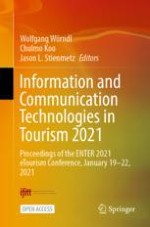1 Introduction
2 Data and Methods
2.1 Social Media Data
2.2 Cellphone Data
2.3 VISIT FLORIDA Survey Data
Origin | Destination | Geo resolution | Timeframe | Time frequency | |
|---|---|---|---|---|---|
Social media data | |||||
Floridian | Yes | Yes | County - County | 2003–2019 | Monthly |
Domestic | Yes | Yes | State - County | 2003–2019 | Monthly |
Int’l | Yes | Yes | Nation - County | 2003–2019 | Monthly |
Cellphone data | |||||
Floridian | Yes | Yes | Tract - Tract | 2018.10–2019.9 | Monthly |
Domestic | Yes | Partial | State - Tract | 2018.10–2019.9 | Monthly |
Int’l | No | No | Not applicable | 2018.10–2019.9 | Monthly |
Survey data | |||||
Floridian | No | No | Not applicable | Not applicable | Not applicable |
Domestic | Yes | Partial | State - Region | 2015–2018 | Seasonal |
Int’l | Yes | Partial | Nation - Region | 2015–2018 | Seasonal |
2.4 Methods
-
to validate the origins of Floridians inferred from the social media, their spatial distributions were compared with the cellphone data. Pearson's r correlation between the log-transformed paired data on the number of visits from each origin was used to estimate the match between different data sources.
-
in a similar way, to validate the origins of domestic visitors, the destination of Floridians, and the travel flows of Floridians, their respective representations in different databases were used.
3 Results
3.1 Validation of Trip Origins
Origin | N Trips Cellphone | N Trips Social media |
|---|---|---|
Palm Beach | 1,531,156 | 15,309 |
Hillsborough | 1,435,614 | 13,325 |
Miami-Dade | 1,205,709 | 12,986 |
Duval | 1,147,412 | 8,711 |
Orange | 1,128,544 | 14,447 |
Broward | 866,250 | 15,048 |
Lee | 830,158 | 9,218 |
Pinellas | 816,220 | 10,156 |
Polk | 757,789 | 4,618 |
Brevard | 674,611 | 6,898 |
Origin State | N Trips Cellphone | N Trips Social media | N Trips Survey 2018 |
|---|---|---|---|
Georgia | 834,620 | 30,639 | 11,935,176 |
New York | 661,042 | 34,242 | 10,021,044 |
California | 368,015 | 11,633 | 4,503,840 |
Texas | 364,626 | 16,726 | 4,841,628 |
North Carolina | 326,272 | 15,850 | 5,292,012 |
New Jersey | 277,725 | 16,661 | 4,729,032 |
Ohio | 271,976 | 18,393 | 4,841,628 |
Pennsylvania | 270,474 | 19,783 | 5,742,396 |
Alabama | 266,281 | 7,955 | 5,404,608 |
Virginia | 266,275 | 12,605 | 3,265,284 |
Illinois | 261,418 | 18,124 | 5,517,204 |
Massachusetts | 203,044 | 14,162 | 3,152,688 |
Michigan | 200,719 | 13,589 | 4,278,648 |
Tennessee | 175,951 | 12,853 | 4,616,436 |
Indiana | 150,297 | 9,280 | 3,603,072 |
Maryland | 141,362 | 8,943 | 2,927,496 |
4 Validation of Destinations
County | N Trips Cellphone | N Trips Social media |
|---|---|---|
Orange | 4,222,721 | 32,014 |
Miami-Dade | 2,573,859 | 9,787 |
Hillsborough | 1,878,658 | 8,779 |
Broward | 911,854 | 8,149 |
Palm Beach | 690,836 | 7,145 |
Polk | 677,824 | 2,978 |
Duval | 622,774 | 5,804 |
Pinellas | 549,217 | 11,055 |
Osceola | 534,319 | 5,746 |
Seminole | 534,261 | 1,893 |
5 Validation of Travel Flows
Origin - destination | N Trips Cellphones | N Trips Social media |
|---|---|---|
Palm Beach - Miami-Dade | 806,358 | 1,619 |
Hillsborough - Orange | 699,457 | 3,606 |
Duval - Orange | 339,657 | 2,187 |
Pinellas - Orange | 326,103 | 2,286 |
Lee - Miami-Dade | 325,180 | 622 |
Duval - Hillsborough | 295,452 | 496 |
Orange - Hillsborough | 284,670 | 1,314 |
Miami-Dade - Palm Beach | 234,129 | 1,109 |
Miami-Dade - Orange | 224,680 | 3,748 |
Marion - Orange | 222,944 | 668 |
